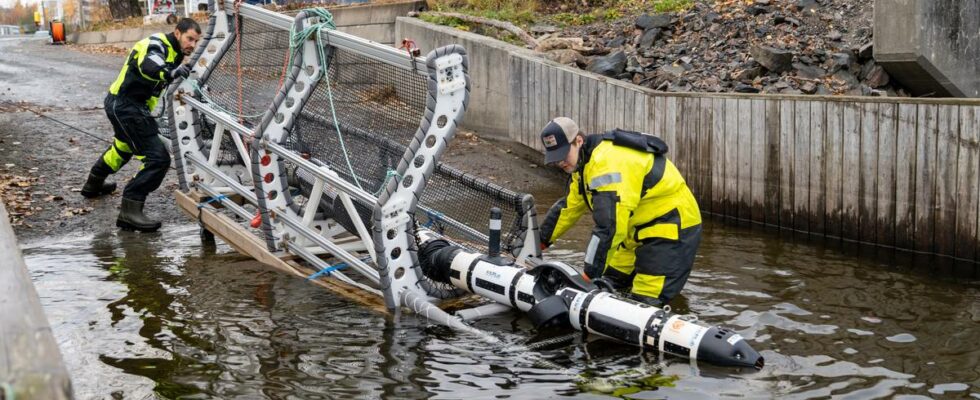The case in summary: A six-metre-long robot will take pictures of defense waste dumped in Mjøsa to examine the condition of the ammunition and whether there is a risk of leakage. Mjøsa is a source of drinking water for 100,000 people in five municipalities, so it is important to find out if there are leaks. The ammunition was dumped during and after the war until the 1970s, mainly between Gjøvik and Mengshol, as well as outside Totenvika. The summary is made by an AI service from OpenAI. The content is quality assured by news’s journalists before publication. It resembles a huge sea serpent that winds its way through the depths. But the unique six-metre hose will be used to take pictures of defense waste lying in the lake. – We hope to gain more knowledge about the condition of the ammunition, how much there is and most of all we want to know if there is any risk of leakage. So says Øyvind Ødegård, researcher in marine archeology at NTNU. Over 30 years, several hundred tonnes of ammunition, bombs and grenades were dumped in Mjøsa. Fear of leaks in drinking water The findings are particularly important since Mjøsa is a source of drinking water for 100,000 people in five municipalities. – The most important thing for us is to find out if there is any danger in connection with it. Whether there are leaks or something that indicates that something needs to be done. Øyvind Ødegård, researcher in marine archeology at NTNU, tells about a particularly good picture from the underwater robot “Eely” which is in action this week. Photo: Knut Røsrud / news It was during the war and until the 1970s that large quantities of defense waste were dumped in Norway’s largest lake. The Norwegian Defense Forces and Raufoss Ammunitionsfabrikker (later Nammo) were responsible for the majority of the pollution. The ammunition is dumped mainly in two areas – between Gjøvik and Mengshol, as well as outside Totenvika. The technology of the underwater robot has never been used in fresh water before. – We hope it can take good pictures of the dump field, which is poorly documented. Many of the grenades are in poor condition, and look as if they have started to corrode, says Jørn Wroldsen, program manager for the “Mission Mjøsa” research project. Also read about the fact that much more ammunition has been dumped in Mjøsa than previously thought: – Like many lakes in the whole of Norway, “Eelume” has meandered around the area between Gjøvik and Mengshol, where it has been dumped the most. The robot is chock full of sensors, and at the front it has a so-called hyperspectral imager. It can photograph 800 colours, and the snake also has joints so that it can change angle and direction, according to Ødegård. It is the first time such an underwater robot has been used and it provides a unique picture of Mjøsa. Photo: NTNU / news Monday was the first day the snake meandered around Mjøsa’s bottom. – We have seen quite a lot, and there are surprisingly good conditions and visibility. That means we have a clear picture, says Ødegård. He says that the snake will run all week and then the data it sends in will be processed until Christmas. The answer can provide many answers and professor at the Institute of Marine Engineering at the Norwegian University of Science and Technology (NTNU), Asgeir Johan Sørensen, hopes that this can be a wake-up call. He believes the challenge of dumping waste in lakes is great. – The problem does not only apply to Mjøsa. It also applies to lakes in Norway and Scandinavia. We have used both seas and lakes to dump waste. I actually think that we need to get a national management regime in place in Norway, says Sørensen. Read about Bjørn who was involved in dumping ammunition in Mjøsa: Praises the municipalities In addition to the dumping of waste, he points to the large quantities of microplastics that are constantly growing. – It has been explosive and is one of the worst we have. We have reason to be concerned, says Sørensen. It is six meters long and is chock full of gadgets. Photo: Knut Røsrud / news He thinks the research project at Mjøsa is exemplary and praises the municipalities around Mjøsa that have signed up for the project. – It is extremely motivating that they take this seriously. We in Norway have expertise in this and now this must be on the agenda. It is an increasing problem, and literally speaking, this is a ticking time bomb, says Sørensen. The underwater robot will trawl in the area between Gjøvik and Mengshol in Ringsaker. Published 30.10.2024, at 18.01
ttn-69
The world’s most advanced robot uncovers the sins in Norway’s largest lake – news Innlandet – Local news, TV and radio

